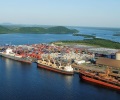[ad_1]
Researchers expect higher than usual concentrations of toxic blue-green algae this summer, spurred on by the persistently warm, calm conditions.
The record-breaking hot weather this summer has warmed the coastal and inland waters. This creates favorable conditions for the growth of cyanobacteria, which can be harmful to humans and animals.
Satellite imagery of marine areas has shown some blue-green algae deposits, and there have also been observations at inland water test points.
On the other hand, winds have mixed the ocean surface water and broken up algal rafts. This was documented by maritime patrol aircraft from the border guard, which flew over southern sea areas on Friday. No large blue-green algae deposits were found in the Gulf of Finland or the Archipelago.
The Finnish Environment Institute (Syke) reported Thursday that cyanobacteria were observed in offshore areas throughout the main basin of the Baltic Sea to the south and west coasts of the autonomous Ã…land Islands.
In the open sea areas of the Gulf of Finland, cyanobacteria occur over a large area in the upper layer of the water mass as far as Gogland (Suursaari) in the eastern Baltic Sea.
If the weather stays calm and warm, cyanobacteria can rise to the surface layer. Individual observations of surface algae were made in open marine areas of the eastern Gulf of Finland north of the islands of Lavansaari, Peninsaari and Seiskari.
“I’m sorry to have to say that, but we’re going in a worse direction all the time,” says Syke Senior Scientist Mika Raateoja said Yle.
Article continues after photo
The water was still good for swimming on Turku’s Ispoinen beach on Friday.
Image: Markku Sandell / Yle
Summer gets hot quickly
Compared to the last few years, we are a few weeks ahead of the usual schedule due to the water heating. Raateoja estimates that the algae situation will worsen in July depending on the weather.
The algae situation is still normal in inland waters, although the sea surface temperatures are above average.
The last summer with strong blue algae bloom was 2018, when the highest temperature ever recorded was measured on the open Baltic Sea: 27 degrees Celsius.
Raateoja refuses to speculate on whether this summer will be just as bad or worse.
“Blue-green algae are a bit like vacationers, that is, the warmer the water, the more comfortable it is to be there,” he said. Cyanobacteria are also accelerated by eutrophication due to human-induced nutrient pollution, including fertilizer runoff from farms.
In the archipelago, surface cyanobacteria have been observed in places, particularly in the marine areas north of Nauvo and Korpo and in the Gullkronanselkä area in the western part of the Turku archipelago. Surface algae are also found elsewhere in the archipelago.
Article continues after photo
Signs on public beaches usually warn of poisonous algae.
Image: Markku Sandell / Yle
According to Janne Suomela, Chief Specialist of the South-West Finland Center for Economic Development, Transport and Environment (Ely), there are more blue-green algae in the archipelago than the average at this point in July.
“That’s because the water is now record warm, which has allowed blue-green algae to grow and multiply faster,” he said.
Abundant deposits of algae have been observed this week in the archipelago near Seili Island, which is part of Pargas Municipality.
According to the Finnish Meteorological Institute, the sea surface temperature is 13-17 degrees Celsius in the Gulf of Bothnia, 11-17 degrees in the Bothnian Sea, 17-21 degrees in the Archipelago and 17-21 degrees in the Gulf of Finland.
Article continues after photo
Algae deposits were observed near the island of Seili this week.
Image: Jari Hänninen / Turun yliopisto
Keep children and pets away from contaminated water
Syke says that due to climate change, the Baltic Sea has warmed an average of nearly two degrees Celsius since 1990, while the Finnish marine areas have warmed even more.
According to Suomela, the exceptional warmth of the water means that there are now good conditions for the cyanobacteria to bloom strongly, and calm and warm weather is forecast for next week, which will push the algae to the surface.
Article continues after photo
Blue-green algae often mix in the water as small particles that rise to the surface when there is no wind.
Image: Ari Haimakainen / Yle
For vacationers, the blue-green algae forecast does not bode well for bathing opportunities, as bathing in waters with blue-green algae is not recommended, which can be particularly harmful to children and pets.
“If you see greenish or yellowish particles in the water, or if the algae have gathered in strips or larger rafts, think twice before you go swimming,” said Suomela.
According to Syke, children and pets are not allowed to get into contaminated water, and adults should also avoid swimming. Any child or pet suspected of having been exposed to contaminated water should be washed thoroughly with clean water, advises the institute.
Water containing blue algae must not be consumed by humans or animals, even after it has been boiled.
[ad_2]







